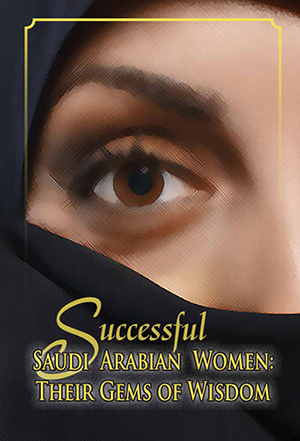Successful Saudi Arabian Women:
Their Gems Of Wisdom
Being a trailblazer is not easy for anyone in any society but, arguably, it might just be a little bit harder for Saudi women. Somehow they have managed to break through and the question is: How did they do that?
From the evidence that their stories provide, there are four essential elements of success: being highly educated, being socially acceptable, being fortunate in the timing of their birth, and most importantly, having had fathers and husbands who enabled and supported their success.
The positive role their fathers played in their lives is particularly notable because—in all cases—girls must have their permission to seek education and their encouragement to leverage it for professional purposes.
This is significant because education is the only proven pathway to professional success for women in Saudi Arabia.
Fathers have unmatched power to encourage and sanction their daughters’ aspirations beyond merely leading a domestic life and, on the flip side, they also have the power to curtail aspirations at an early age. Husbands too possess the power to add fuel to the fire or to extinguish it. Thus first, the girl must aspire to be successful and to become educated; next, the father must sanction her dreams, and finally, the husband must permit those dreams to be realized.
At the heart of the equation is the girl herself. How does she become inspired to aspire?

Most of the women profiled here had access to only tiny bits of information during their childhood, which came mostly from books their mothers typically could not read. Those little nuggets fired up their imaginations and, like coals in a fire, their dreams burned brightly. Visions of a future brighter than the fate of most females in their immediate family and environments shone before them.
Making their dreams come true wasn’t easy, however. Being the first in their family to study a particular discipline or to study in the west, as all in this book did, was challenging. They had to master the English language and study long and hard for many years to get where they are today. While they were studying, most also had multiple children and had to figure out how to effectively navigate new societies in the west while holding true to their customs and religion.
It is important to understand that success for women in Saudi Arabia always has two dimensions: professional and personal. Professionally, Saudi women are expected to obtain the highest level of academic credentials possible and then draw on their network to get a job that permits them to productively apply that knowledge.
Personal success encompasses much more, requiring Saudi women to walk a thin line between being different – because of their high level of education – while also fitting in because of their adherence to shared values and customs.

The latter is what makes this book a breakthrough. Saudi professional women have mastered how to fit in. Therefore, stepping out to tell their individual personal stories is a big step and one they have taken with a degree of caution and apprehension.
In Saudi Arabia, family is the most important social institution. It is the primary basis of identity and status, and the immediate focus of individual loyalty. A successful Saudi woman is one whose personal and professional aspirations are sanctioned and approved by her family. Because the possession of academic credentials alone is insufficient for conferring high social status, there is a limit to the degree to which women are willing to be outliers in order to be “professionally successful.” Saudi women must, above all, successfully navigate society and be accepted by society.
Saudi society values behavior that displays generosity, selflessness and hospitality. Importantly, it values deference to hierarchy in the family, mastery over one’s emotions, as well as a willingness to support other family members and assume responsibility for their errors.
Two main themes appear throughout the stories of the women in this book: acceptance and navigation. To make it in this world, these women had to accept that which society was not ready to change: arranged marriages, covering up, seeking permission from their fathers or husbands at every turn and having limited mobility. These same women spotted and seized opportunities outside of traditional expectations, making them captains of their own destiny, which is and where navigation comes in.
The women in this book embraced educational opportunity, but luck also played an important role. They were lucky enough to have the support of their fathers and husbands. Timing was also important. They all received scholarships at a time when that narrow window of opportunity was beginning to open.
Their mothers didn’t have that window. Most of the women in this book have mothers who are only about a decade and a half older than themselves who were customarily forced to be illiterate.
 If this were a book about “unsuccessful” Saudi Arabian women we might read one story after another of women who never got out of the gate, those that never had a chance. But, that’s another book. Unabashedly, this is a book about the “glass being half full.” It presents small insights into the hearts and stories of Saudi Arabian women who made it based on their education, acumen and personal navigation of the society. One thing about their “half full glasses:” they had to “dance” without spilling its contents.
If this were a book about “unsuccessful” Saudi Arabian women we might read one story after another of women who never got out of the gate, those that never had a chance. But, that’s another book. Unabashedly, this is a book about the “glass being half full.” It presents small insights into the hearts and stories of Saudi Arabian women who made it based on their education, acumen and personal navigation of the society. One thing about their “half full glasses:” they had to “dance” without spilling its contents.
The “break out” stories revealed in this book illustrate the gigantic leap women have taken in Saudi Arabia in the past few decades when, not long before, it was frowned upon (or worse) even to mention the whole name of a female in public. These women have placed themselves in the spotlight to tell their stories, to whatever degree of frankness, which is a very big step of self-assertion. While the entirety of their back stories aren’t necessarily revealed, we’re grateful for the insights and, indeed, for the gems of wisdom they have shared.
It is not possible to fully appreciate the stories in this book without understanding the societal and cultural context in which they have occurred. For instance, when a woman says, “I am grateful to my husband for his support,” that is more than a casual statement because a husband must give his support for what his wife is doing or it is unlikely she would be permitted to do it. Acts considered to be routine in other countries such as leaving the house, visiting other cities, regions, or countries, working alongside men and even being employed require the husband’s permission in Saudi Arabia. Thus, as we applaud the women in this book for their accomplishments, we must also applaud their fathers and spouses who both allowed and encouraged them.
The key when reading these stories is to be mindful of time. If a woman was born in the 1950s, that means one thing in terms of the information she had at her disposal and about the prevailing norms and attitudes of that time; if she was born in the 1960s, it was different, and so on.
What were the barriers each woman profiled had to overcome given the period in which she came of age? This is a question that cannot be fully be answered in the confines of this book, for some barriers are undoubtedly internal to the person and her family, while others are externally imposed. What we know for certain is that every move the woman makes has circles of influence and consent around it, with one sphere inside another, and another, and another.
Societal change, especially as it relates to women within Saudi Arabia, entails a process of “bringing up the rear.” Accordingly, acceptance of societal change occurs at different rates within the society, typically from the front to the back rather than the other way around. At the “front” are the enlightened ones, the broadly educated people and at the “rear” are those who are not. The latter group is composed of both women and men who were born at a time and in a place that did not permit them to be educated in ways other than how they were educated, if they were educated at all.
Today’s Saudi Arabia stands with one foot firmly placed among the most highly developed nations of the world with the other lagging behind. It still has a substantial population that lives in rural areas distant from developed urban centers, with some living as nomadic and semi-nomadic herdsmen and others as oasis agricultural workers. Well into the 20th century, several great deserts cut tribal groups off from one another and isolated Najd from other areas of the country, resulting in a high degree of cultural and religious homogeneity among the inhabitants. The majority follow Sunni Wahhabi Islam and embrace a patriarchal family system. While the desert can be more easily traversed today, the great gulf between conservative and liberal viewpoints remains far apart.
Saudi Arabia’s population continues to present a picture of cultural contrasts. On the one hand, Saudi people feel a strong desire to live one’s life according to God’s laws as revealed through the Quran and the life of the Prophet Muhammad. At the same time, the interpretation of what it means to live according to God’s laws has assumed different meanings to different groups of people: some wish to adjust traditional values to the circumstances of the present while others wish to adjust the circumstances of the present to traditional values. In no aspect of Saudi society is this tension more manifest than in the question of the role of women. The conservative view favors complete separation of women from men in public life, with the education of women devoted to domestic skills, whereas the liberal view has sought to transform “separation values” into “modesty values,” allowing the expansion of women’s opportunities in work and education.
As the debate rages on, the women in this book quietly and cleverly seized educational opportunities, laying the foundation to become indispensable to Saudi society by virtue of the knowledge and unique skills they possess.
Saudi society is complex, rich in both history and culture, and imbued with certain social contracts. The following offers a brief overview of Saudi Arabia’s history, culture, and some of the social contracts.

